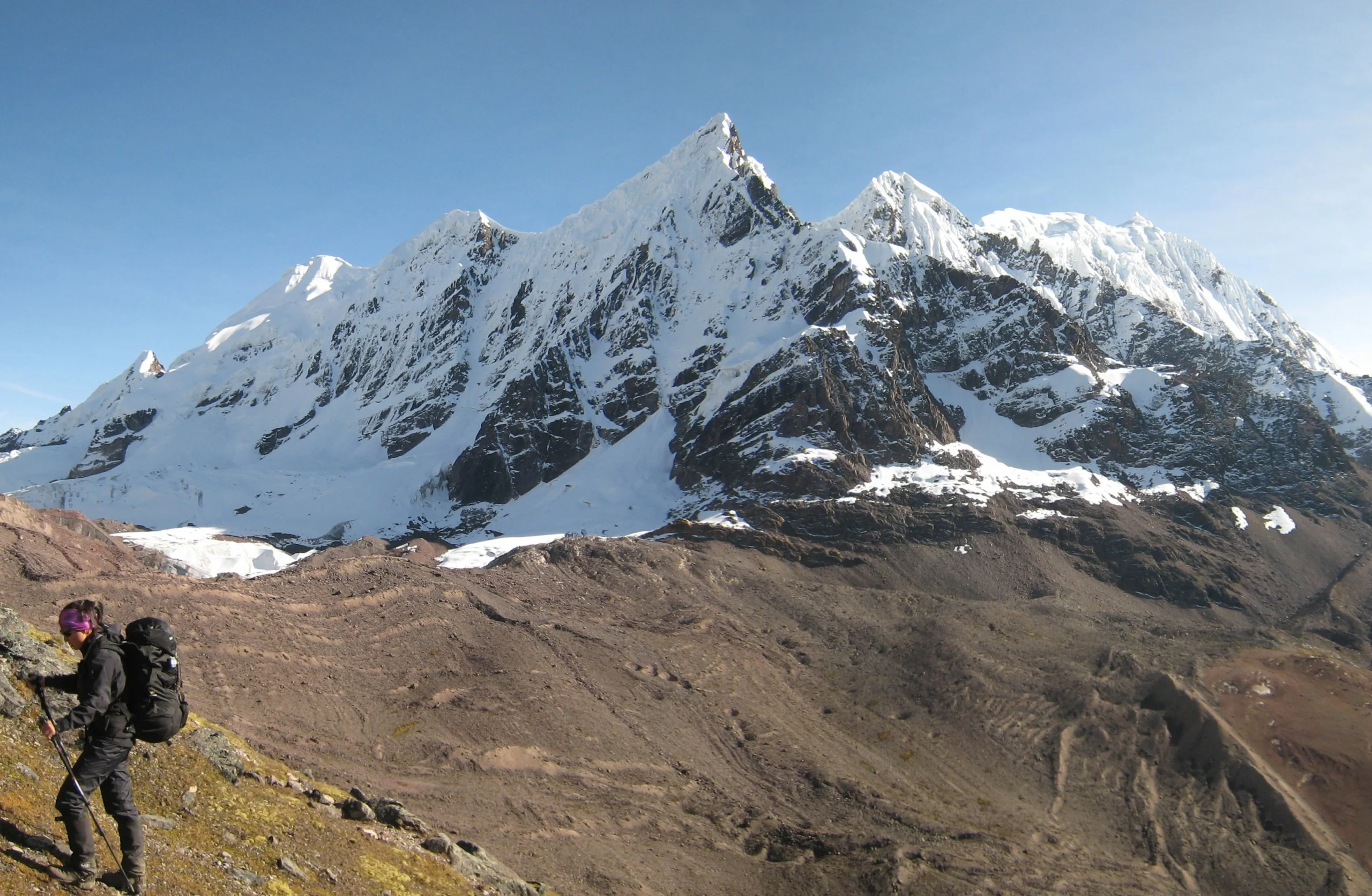The Snow-Capped Mountains in Cusco | The tallest in the Peruvian Andes
Around the world, Peru is a country of breathtaking landscapes, where the Andes mountain range cuts across its territory, leaving behind snow-capped mountains in Cusco with majestic peaks that touch the sky and valleys that are a dream for many. These snow-covered mountains are not only challenges for mountaineers and natural treasures, but also spiritual guardians for the Andean cultures, who consider them sacred “Apus,” the millennial protectors of the Andean world. That is why, together with Kantu Peru Tours, we invite you to get to know the tallest and most important snow-capped mountains in Cusco and other mountain ranges in Peru.

A family in the Salkantay Treking to Machu Picchu
What is a snow-capped mountain?
A snow-capped mountain is a mountain that is permanently covered with snow and ice, usually located in high-altitude areas, such as the Andes mountain range, which branches into three main ranges in the country. In Peru, snow-capped mountains are important not only for their natural beauty, but also because they are sources of fresh water, as their melting snow feeds rivers and lakes. Moreover, many of them have a sacred meaning in the Andean worldview.
What are Apus in Perú?
Apus are mountain spirits or deities in the Andean worldview and are considered protectors of communities, providers of life and energy, and mediators between the human world and the spiritual world. Apus have been venerated since ancient times, and many people in the Andes offer them tributes and ceremonies to ask for well-being, good harvests, and protection.

Hombre andino en los nevados peruanos
What is the relationship between Apus and snow-capped mountains?
In Cusco, many snow-capped mountains are considered Apus due to their imposing presence and their importance in the lives of communities. For example, the Apu Ausangate (the Ausangate snow-capped mountain) is one of the most sacred in the region and is believed to have great spiritual power. During the Qoyllur Rit’i, an Andean festival, pilgrims climb the glaciers to honor these Apus and perform rituals. Thus, snow-capped mountains are not only sources of water and landscapes, but also pillars of the cultural and religious identity of Cusco.
Snow-Capped Mountains in Cusco of the Vilcanota Range
Ausangate Snow-Capped Mountain
The Ausangate is the tallest snow-capped mountain in the Cusco region and one of the most revered. In addition to being considered a protective Apu, it is the center of the Qoyllur Rit’i pilgrimage, one of the most important festivals in the Andean world. Snow-capped mountains in Cusco like the Ausangate offer impressive trekking routes, with glacial lakes and high-altitude grasslands that form a unique landscape. Moreover, local communities perform ceremonies and rituals in honor of this sacred snow-capped mountain.
→ Altitude: 20,948 feet above sea level.
→ Location: Quispicanchi Province, Cusco region.

Nevado-Ausangate-Nevados-en-Cusco
Callangate Snow-Capped Mountain
Continuing with the snow-capped mountains in Cusco, it is essential to mention the Callangate, also known as Collpa Ananta. It is the second tallest snow-capped mountain in the Vilcanota Range. Its melting snow feeds the Urubamba River basin, and it is considered the younger brother of Ausangate. Snow-capped mountains in Cusco like the Callangate are ideal for hiking and nature observation, with the opportunity to visit indigenous villages and learn about their culture and traditions.
→ Altitude: 20,046 feet above sea level.
→ Location: Quispicanchi Province, Cusco region.

Callangate-snow-capped-mountain
Snow-Capped Mountains in Cusco of the Vilcabamba Range
Salkantay Snow-Capped Mountain
The Salkantay is the tallest snow-capped mountain in the Vilcabamba Range and the second tallest in the Cusco region. It is known as the tutelary Apu of Cusco and has maintained a position of supremacy since the Inca period. Snow-capped mountains in Cusco like the Salkantay offer trekking with impressive views of condors and alpacas in their natural habitat and is part of one of the alternative routes to Machu Picchu.
→ Altitude: 20,574 feet above sea level.
→ Location: La Convención Province, Cusco region.

Salkantay Mountain
Humantay Snow-Capped Mountain
According to an ancient legend, Humantay is the youngest son of the Apu Salkantay and is responsible for distributing water to the population. Nowadays, many tours offer trekking to the Humantay Lake, where the emerald waters spectacularly reflect the landscape. It is an ideal place to enjoy nature and tranquility.
→ Altitude: 17,126 feet above sea level.
→ Location: Anta Province, Cusco region.

Humantay Lake drone view
Snow-Capped Mountains in Cusco of the Urubamba Range
La Verónica Snow-Capped Mountain
The La Verónica Snow-Capped Mountain, also known as Wakaywillque (Sacred Tear), is one of the tallest peaks in the Urubamba Range. Snow-capped mountains in Cusco like La Verónica offer trekking with impressive views of mountains, valleys, lakes, and rivers. Its rugged topography and steep slopes make it an exciting destination for adventure lovers.
→ Altitude: 19,003 feet above sea level.
→ Location: Urubamba Province, Cusco region.

Nevado La Verónica en Cusco
Chicón Snow-Capped Mountain
The Chicón, also known as the “Veil of the Bride,” is one of the most incredible snow-capped mountains for climbing and mountaineering. It also offers impressive views from its summit, where you can see other snow-capped mountains and the Sacred Valley. It is an ideal place for mountain and adventure lovers.
→ Altitude: 18,143 feet above sea level.
→ Location: Urubamba Province, Cusco region.
Nevado Chicón en Urubamba Cusco
Other Mountain Ranges in Peru
Huascarán – The White Giant of the Andes (Áncash)
Huascarán is the tallest peak in Peru and is located in the heart of the White Range. Snow-capped mountains in Cusco and other places like Huascarán offer mountaineering, trekking, and visits to glacial lakes in an environment of great natural beauty.
→ Altitude: 22,169 feet above sea level.
→ Location: Yungay and Carhuaz provinces, Áncash region.

Huascarán Cusco Snow-capped mountain
Yerupajá – The Most Challenging Summit (Huánuco, Áncash, and Lima)
Known as “the colossus of Huayhuash,” Yerupajá is one of the most complex challenges in South American mountaineering. Snow-capped mountains in Cusco and others like Yerupajá offer mountaineering and trekking in a high mountain environment with impressive views.
→ Altitude: 21,768 feet above sea level.
→ Location: Huayhuash Range, between the regions of Huánuco, Áncash, and Lima.

Nevado de Yerupajá en Perú
Coropuna – The Golden Mountain of the South (Arequipa)
Coropuna is the tallest mountain in southern Peru and an ancient dormant volcano. Snow-capped mountains in Cusco and other places like Coropuna offer trekking and visits to archaeological remains, demonstrating its importance as a sacred sanctuary.
→ Altitude: 21,083 feet above sea level.
→ Location: Castilla Province, Arequipa region.

Nevado Coropuna en Arequipa Perú
Huandoy – The Stone Hearth (Áncash)
Huandoy is known as “burning stone” or “mountain hearth” and is one of the most impressive snow-capped mountains in the White Range. Snow-capped mountains in Cusco and others like Huandoy offer trekking and mountaineering in a glacial environment with scenic routes.
→ Altitude: 20,981 feet above sea level.
→ Location: Yungay District, Áncash region.

Nevados en Perú – Huandoy
The snow-capped mountains in Cusco and other regions of Peru are majestic natural treasures that combine beauty, adventure, and spirituality, each snow-capped mountain, from Ausangate to Huascarán, offers unique experiences and a variety of activities. These places are not only destinations for mountaineers but also guardians of Andean culture.
Respecting and protecting these snow-capped mountains is crucial to preserve their majesty and cultural significance, and remember that for a complete and safe experience, Kantu Peru Tours offers comprehensive packages to visit Peru. We’re happy to assist with any questions or needs you may have!🌄✨








